Regional New Particle Formation over the Eastern Mediterranean and Middle East
Abstract
:1. Introduction
2. Experimental Setup and Data Analysis
2.1. Measurements
2.2. Data Analysis
2.3. Ancillary Data
3. Results and Discussion
3.1. Particle Number Size Distributions
3.2. NPF Events
3.3. Simultaneous NPF Events
3.3.1. Conditions Favoring Common NPF at All Three Stations
3.3.2. Relevant NPF Events at Two Stations (Finokalia and Amman)
4. Conclusions
Supplementary Materials
Author Contributions
Funding
Institutional Review Board Statement
Informed Consent Statement
Data Availability Statement
Acknowledgments
Conflicts of Interest
References
- Nieminen, T.; Kerminen, V.-M.; Petäjä, T.; Aalto, P.P.; Arshinov, M.; Asmi, E.; Baltensperger, U.; Beddows, D.C.S.; Beukes, J.P.; Collins, D.; et al. Global analysis of continental boundary layer new particle formation based on long-term measurements. Atmos. Chem. Phys. 2018, 18, 14737–14756. [Google Scholar] [CrossRef] [Green Version]
- Kalivitis, N.; Kerminen, V.-M.; Kouvarakis, G.; Stavroulas, I.; Bougiatioti, A.; Nenes, A.; Manninen, H.E.; Petäjä, T.; Kulmala, M.; Mihalopoulos, N. Atmospheric new particle formation as a source of CCN in the eastern Mediterranean marine boundary layer. Atmos. Chem. Phys. 2015, 15, 9203–9215. [Google Scholar] [CrossRef] [Green Version]
- Kalkavouras, P.; Bougiatioti, A.; Kalivitis, N.; Stavroulas, I.; Tombrou, M.; Nenes, A.; Mihalopoulos, N. Regional new particle formation as modulators of cloud condensation nuclei and cloud droplet number in the eastern Mediterranean. Atmos. Chem. Phys. 2019, 19, 6185–6203. [Google Scholar] [CrossRef] [Green Version]
- Dal Maso, M.; Kulmala, M.; Riipinen, I.; Wagner, R.; Hussein, T.; Aalto, P.P.; Lehtinen, K.E.J. Formation and growth of fresh atmospheric aerosols: Eight years of aerosol size distribution data from SMEAR II, Hyytiälä, Finland. Boreal Environ. Res. 2005, 10, 323–336. [Google Scholar]
- Dai, L.; Wang, H.L.; Zhou, L.Y.; An, J.L.; Tang, L.L.; Lu, C.S.; Yan, W.L.; Liu, R.Y.; Kong, S.F.; Chen, M.D.; et al. Regional and local new particle formation events observed in the Yangtze River Delta region, China. J. Geophys. Res. Atmos. 2017, 122, 2389–2402. [Google Scholar] [CrossRef]
- Kulmala, M.; Vehkamäki, H.; Petäjä, T.; Dal Maso, M.; Lauri, A.; Kerminen, V.-M.; Birmili, W.; McMurry, P.H. Formation and growth rates of ultrafine atmospheric particles: A review of observations. J. Aerosol Sci. 2004, 35, 143–176. [Google Scholar] [CrossRef]
- Hussein, T.; Junninen, H.; Tunved, P.; Kristensson, A.; Dal Maso, M.; Riipinen, I.; Aalto, P.P.; Hansson, H.-C.; Swietlicki, E.; Kulmala, M. Time span and spatial scale of regional new particle formation events over Finland and Southern Sweden. Atmos. Chem. Phys. 2009, 9, 4699–4716. [Google Scholar] [CrossRef] [Green Version]
- Németh, Z.; Rosati, B.; Zíková, N.; Salma, I.; Bozó, L.; Dameto de España, C.; Schwarz, J.; Ždímal, V.; Wonaschütz, A. Comparison of atmospheric new particle formation events in three Central European cities. Atmos. Environ. 2018, 178, 191–197. [Google Scholar] [CrossRef]
- Kalkavouras, P.; Bossioli, E.; Bezantakos, S.; Bougiatioti, A.; Kalivitis, N.; Stavroulas, I.; Kouvarakis, G.; Protonotariou, A.P.; Dandou, A.; Biskos, G.; et al. New particle formation in the southern Aegean Sea during the Etesians: Importance for CCN production and cloud droplet number. Atmos. Chem. Phys. 2017, 17, 175–192. [Google Scholar] [CrossRef] [Green Version]
- Kalkavouras, P.; Bougiatioti, A.; Grivas, G.; Stavroulas, I.; Kalivitis, N.; Liakakou, E.; Gerasopoulos, E.; Pilinis, C.; Mihalopoulos, N. On the regional aspects of new particle formation in the Eastern Mediterranean: A comparative study between a background and an urban site based on long term observations. Atmos. Res. 2020, 239, 104911. [Google Scholar] [CrossRef]
- Wehner, B.; Siebert, H.; Stratmann, F.; Tuch, T.; Wiedensohler, A.; Petäjä, T.; Dal Maso, M.; Kulmala, M. Horizontal homogeneity and vertical extent of new particle formation events. Tellus 2007, 59, 362–371. [Google Scholar] [CrossRef] [Green Version]
- Hussein, T.; Atashi, N.; Sogacheva, L.; Hakala, S.; Dada, L.; Petäjä, T.; Kulmala, M. Characterization of Urban New Particle Formation in Amman—Jordan. Atmosphere 2020, 11, 79. [Google Scholar] [CrossRef] [Green Version]
- Grivas, G.; Stavroulas, I.; Liakakou, E.; Kaskaoutis, D.G.; Bougiatioti, A.; Paraskevopoulou, D.; Gerasopoulos, E.; Mihalopoulos, N. Measuring the spatial variability of Black Carbon in Athens during wintertime. Air Qual. Atmos. Health 2019, 12, 1405–1417. [Google Scholar] [CrossRef]
- Theodosi, C.; Tsagkaraki, M.; Zarmpas, P.; Grivas, G.; Liakakou, E.; Paraskevopoulou, D.; Lianou, M.; Gerasopoulos, E.; Mihalopoulos, N. Multi-year chemical composition of the fine aerosol fraction in Athens, Greece, with emphasis on the contribution of residential heating in wintertime. Atmos. Chem. Phys. 2018, 18, 14371–14391. [Google Scholar] [CrossRef] [Green Version]
- Stavroulas, I.; Bougiatioti, A.; Paraskevopoulou, D.; Grivas, G.; Liakakou, E.; Gerasopoulos, E.; Mihalopoulos, N. Sources and processes that control the submicron organic aerosol in an urban Mediterranean environment (Athens) using high temporal resolution chemical composition measurements. Atmos. Chem. Phys. 2019, 19, 901–919. [Google Scholar] [CrossRef] [Green Version]
- Mihalopoulos, N.; Stephanou, E.; Kanakidou, M.; Pilitsidis, S.; Bousquet, P. Tropospheric aerosol ionic composition in the Eastern Mediterranean region. Tellus B 1997, 49, 314–326. [Google Scholar] [CrossRef]
- Lelieveld, J.; Berresheim, H.; Borrmann, S.; Crutzen, P.; Dentener, F.; Fischer, H.; Feichter, J.; Flatau, P.; Heland, J.; Holzinger, R.; et al. Global air pollution crossroads over the Mediterranean. Science 2002, 298, 794–799. [Google Scholar] [CrossRef] [Green Version]
- Wang, C.S.; Flagan, C.R. Scanning electrical mobility spectrometer. Aerosol Sci. Technol. 1990, 13, 230–240. [Google Scholar] [CrossRef]
- Kalivitis, N.; Kerminen, V.-M.; Kouvarakis, G.; Stavroulas, I.; Tzitzikalaki, E.; Kalkavouras, P.; Daskalakis, N.; Myriokefalitakis, S.; Bougiatioti, A.; Manninen, H.E.; et al. Formation and growth of atmospheric nanoparticles in the eastern Mediterranean: Results from long-term measurements and process simulations. Atmos. Chem. Phys. 2019, 19, 2671–2686. [Google Scholar] [CrossRef] [Green Version]
- Wiedensohler, A.; Birmili, W.; Nowak, A.; Sonntag, A.; Weinhold, K.; Merkel, M.; Wehner, B.; Tuch, T.; Pfeifer, S.; Fiebig, M.; et al. Mobility particle size spectrometers: Harmonization of technical standards and data structure to facilitate high quality long-term observations of atmospheric particle number size distributions. Atmos. Meas. Tech. 2012, 5, 657–685. [Google Scholar] [CrossRef] [Green Version]
- Dada, L.; Chellapermal, R.; Buenrostro Mazon, S.; Paasonen, P.; Lampilahti, J.; Manninen, H.E.; Junninen, H.; Petäjä, T.; Kerminen, V.-M.; Kulmala, M. Refined classification and characterization of atmospheric new-particle formation events using air ions. Atmos. Chem. Phys. 2018, 18, 17883–17893. [Google Scholar] [CrossRef] [Green Version]
- Hussein, T.; Martikainen, J.; Junninen, H.; Sogacheva, L.; Wagner, R.; Dal Maso, M.; Riipinen, I.; Aalto, P.P.; Kulmala, M. Observation of regional new particle formation in the urban atmosphere. Tellus B Chem. Phys. Meteorol. 2008, 60, 509–521. [Google Scholar] [CrossRef]
- Hussein, T.; Dal Maso, M.; Petaja, T.; Koponen, I.K.; Paatero, P.; Aalto, P.P.; Hameri, K.; Kulmala, M. Evaluation of an automatic algorithm for fitting the particle number size distributions. Boreal Environ. Res. 2005, 10, 337–355. [Google Scholar]
- Kulmala, M.; Petäjä, T.; Nieminen, T.; Sipilä, M.; Manninen, H.E.; Lehtipalo, K.; Dal Maso, M.; Aalto, P.; Junninen, H.; Paasonen, P.; et al. Measurement of the nucleation of atmospheric aerosol particles. Nat. Protocol. 2012, 7, 1651–1667. [Google Scholar] [CrossRef]
- Fuchs, N.A.; Sutugin, A.G. Highly dispersed aerosol. In International Reviews in Aerosol Physics and Chemistry: Topics in Current Aerosol Research; Hidy, G.M., Brock, J.R., Eds.; Pergamon: New York, NY, USA, 1971. [Google Scholar]
- Kulmala, M.; Kerminen, V.-M.; Petäjä, T.; Ding, A.J.; Wang, L. Atmospheric gas-to-particle conversion: Why NPF events are observed in megacities? Faraday Discuss. 2017, 200, 271–288. [Google Scholar] [CrossRef]
- Pisso, I.; Sollum, E.; Grythe, H.; Kristiansen, N.I.; Cassiani, M.; Eckhardt, S.; Arnold, D.; Morton, D.; Thompson, R.L.; Groot Zwaaftink, C.D.; et al. The Lagrangian particle dispersion model FLEXPART version 10.4. Geosci. Model Dev. 2019, 12, 4955–4997. [Google Scholar] [CrossRef] [Green Version]
- Gong, X.; Wex, H.; Müller, T.; Wiedensohler, A.; Höhler, K.; Kandler, K.; Ma, N.; Dietel, B.; Schiebel, T.; Möhler, O.; et al. Characterization of aerosol properties at Cyprus, focusing on cloud condensation nuclei and ice-nucleating particles. Atmos. Chem. Phys. 2019, 19, 10883–10900. [Google Scholar] [CrossRef] [Green Version]
- Stein, A.F.; Draxler, R.R.; Rolph, G.D.; Stunder, B.J.B.; Cohen, M.D.; Ngan, F. NOAA’s HYSPLIT atmospheric transport and dispersion modeling system. Bull. Am. Meteorol. Soc. 2015, 96, 2059–2077. [Google Scholar] [CrossRef]
- Casquero-Vera, J.A.; Lyamani, H.; Dada, L.; Hakala, S.; Paasonen, P.; Román, R.; Fraile, R.; Petäjä, T.; Olmo-Reyes, F.J.; Alados-Arboledas, L. New particle formation at urban and high-altitude remote sites in the south-eastern Iberian Peninsula. Atmos. Chem. Phys. Discuss. 2020. in review. [Google Scholar] [CrossRef]
- Asmi, A.; Wiedensohler, A.; Laj, P.; Fjaeraa, A.-M.; Sellegri, K.; Birmili, W.; Weingartner, E.; Baltensperger, U.; Zdimal, V.; Zikova, N.; et al. Number size distributions and seasonality of submicron particles in Europe 2008–2009. Atmos. Chem. Phys. 2011, 11, 5505–5538. [Google Scholar] [CrossRef] [Green Version]
- Pey, J.; Alastuey, A.; Querol, X.; Rodríguez, S. Monitoring of sources and atmospheric processes controlling air quality in an urban Mediterranean environment. Atmos. Environ. 2010, 44, 4879–4890. [Google Scholar] [CrossRef]
- Mejía, J.F.; Morawska, L.; Mengersen, K. Spatial variation in particle number size distributions in a large metropolitan area. Atmos. Chem. Phys. 2008, 8, 1127–1138. [Google Scholar] [CrossRef] [Green Version]
- Kalivitis, N.; Kouvarakis, G.; Bougiatioti, A.; Stavroulas, I.; Wiedensohler, A.; Mihalopoulos, N. Five-years of atmospheric aerosol number size distribution measurements in Eastern Mediterranean. Geophys. Res. Abstr. 2014, 16, 15860. [Google Scholar]
- Hussein, T.; Dada, L.; Hakala, S.; Petäjä, T.; Kulmala, M. Urban aerosol particle size characterization in Eastern Mediterranean conditions. Atmosphere 2019, 10, 710. [Google Scholar] [CrossRef] [Green Version]
- Li, H.; Zhang, Q.; Zheng, B.; Chen, C.; Wu, N.; Guo, H.; Zhang, Y.; Zheng, Y.; Li, X.; He, K. Nitrate-driven urban haze pollution during summertime over the North China Plain. Atmos. Chem. Phys. 2018, 18, 5293–5306. [Google Scholar] [CrossRef] [Green Version]
- Yao, L.; Garmash, O.; Bianchi, F.; Zheng, J.; Yan, C.; Kontkanen, J.; Junninen, H.; Mazon, S.B.; Ehn, M.; Paasonen, P.; et al. Atmospheric new particle formation from sulfuric acid and amines in a Chinese megacity. Science 2018, 361, 278–281. [Google Scholar] [CrossRef] [Green Version]
- Celik, S.; Drewnick, F.; Fachinger, F.; Brooks, J.; Darbyshire, E.; Coe, H.; Paris, J.-D.; Eger, P.G.; Schuladen, J.; Tadic, I.; et al. Influence of vessel characteristics and atmospheric processes on the gas and particle phase of ship emission plumes: In situ measurements in the Mediterranean Sea and around the Arabian Peninsula. Atmos. Chem. Phys. 2020, 20, 4713–4734. [Google Scholar] [CrossRef] [Green Version]
- Vana, M.; Kulmala, M.; Dal Maso, M.; Hõrrak, U.; Tamm, E. Comparative study of nucleation mode aerosol particles and intermediate air ions formation events at three sites. J. Geophys. Res. 2004, 109, D17201. [Google Scholar] [CrossRef] [Green Version]
- Hama, S.M.L.; Cordell, R.L.; Kos, G.P.A.; Weijers, E.P.; Monks, P.S. Sub-micron particle number size distribution characteristics at two urban locations in Leicester. Atmos. Res. 2017, 194, 1–16. [Google Scholar] [CrossRef] [Green Version]
- Kanawade, V.P.; Tripathi, S.N.; Siingh, D.; Gautam, A.S.; Srivastava, A.K.; Kamra, A.K.; Soni, V.K.; Sethi, V. Observations of new particle formation at two distinct Indian subcontinental urban locations. Atmos. Environ. 2014, 96, 370–379. [Google Scholar] [CrossRef]
- Wu, Z.J.; Hu, M.; Liu, S.; Wehner, B.; Bauer, S.; Maßling, A.; Wiedensohler, A.; Petäjä, T.; Dal Maso, M.; Kulmala, M. New particle formation in Beijing, China: Statistical analysis of a 1-year data set. J. Geophys. Res. 2007, 112, D09209. [Google Scholar] [CrossRef]
- Hakala, S.; Alghamdi, M.A.; Paasonen, P.; Vakkari, V.; Khoder, M.I.; Neitola, K.; Dada, L.; Abdelmaksoud, A.S.; Al-Jeelani, H.; Shabbaj, I.I.; et al. New particle formation, growth and apparent shrinkage at a rural background site in western Saudi Arabia. Atmos. Chem. Phys. 2019, 19, 10537–10555. [Google Scholar] [CrossRef] [Green Version]
- Charron, A.; Birmili, W.; Harrison, R.M. Factors influencing new particle formation at the rural site, Harwell, UK. J. Geophys. Res. 2007, 112, D14210. [Google Scholar] [CrossRef] [Green Version]
- Stanier, C.O.; Khlystov, A.Y.; Pandis, S.N. Ambient aerosol size distributions and number concentrations measured during the Pittsburgh Air Quality Study (PAQS). Aerosol Sci. Technol. 2004, 38, 253–264. [Google Scholar] [CrossRef] [Green Version]
- Nilsson, E.D.; Paatero, J.; Boy, M. Effects of air masses and synoptic weather on aerosol formation in the continental boundary layer. Tellus B Chem. Phys. Meteorol. 2001, 53, 462–478. [Google Scholar] [CrossRef]
- Chen, H.; Hodshire, A.L.; Ortega, J.; Greenberg, J.; McMurry, P.H.; Carlton, A.G.; Pierce, J.R.; Hanson, D.R.; Smith, J.N. Vertically resolved concentration and liquid water content of atmospheric nanoparticles at the US DOE Southern Great Plains site. Atmos. Chem. Phys. 2018, 18, 311–326. [Google Scholar] [CrossRef] [Green Version]
- Triantafyllou, A.G. PM10 pollution episodes as a function of synoptic climatology in a mountainous industrial area. Environ. Poll. 2001, 112, 491–500. [Google Scholar] [CrossRef]
- Kouvarakis, G.; Mihalopoulos, N. Seasonal variation of dimethylsulfide in the gas phase and of methanesulfonate and non-sea-salt sulfate in the aerosols phase in the Eastern Mediterranean atmosphere. Atmos. Environ. 2002, 36, 929–938. [Google Scholar] [CrossRef]
- Leck, C.; Bigg, E.K. New particle formation of marine biological origin. Aerosol Sci. Technol. 2010, 44, 570–577. [Google Scholar] [CrossRef]
- O’ Dowd, C.D.; Monahan, C.; Dall’ Osto, M. On the occurrence of open ocean particle production events. Geophys. Res. Lett. 2010, 37, L19805. [Google Scholar] [CrossRef]
- Richards, N.A.D.; Arnold, S.R.; Chipperfield, M.P.; Miles, G.; Rap, A.; Siddans, R.; Monks, S.A.; Hollaway, M.J. The Mediterranean summertime ozone maximum: Global emission sensitivities and radiative impacts. Atmos. Chem. Phys. 2013, 13, 2331–2345. [Google Scholar] [CrossRef] [Green Version]
- Dupart, Y.; King, S.M.; Nekat, B.; Nowak, A.; Wiedensohler, A.; Herrmann, H.; David, G.; Thomas, B.; Miffre, A.; Rairoux, P.; et al. Mineral dust photochemistry induces nucleation events in the presence of SO2. Proc. Natl. Acad. Sci. USA 2012, 109, 20842–20847. [Google Scholar] [CrossRef] [PubMed] [Green Version]
- Nie, W.; Ding, A.; Wang, T.; Kerminen, V.-M.; George, C.; Xue, L.; Wang, W.; Zhang, Q.; Petäjä, T.; Qi, X.; et al. Polluted dust promotes new particle formation and growth. Sci. Rep. 2014, 4, 6634. [Google Scholar] [CrossRef] [PubMed] [Green Version]
- Mönkkönen, P.; Koponen, I.K.; Lehtinen, K.E.J.; Hämeri, K.; Uma, R.; Kulmala, M. Measurements in a highly polluted Asian mega city: Observations of aerosol number size distribution, modal parameters and nucleation events. Atmos. Chem. Phys. 2005, 5, 57–66. [Google Scholar] [CrossRef] [Green Version]
- Freutel, F.; Schneider, J.; Drewnick, F.; von der Weiden-Reinmüller, S.-L.; Crippa, M.; Prévôt, A.S.H.; Baltensperger, U.; Poulain, L.; Wiedensohler, A.; Sciare, J.; et al. Aerosol particle measurements at three stationary sites in the megacity of Paris during summer 2009: Meteorology and air mass origin dominate aerosol particle composition and size distribution. Atmos. Chem. Phys. 2013, 13, 933–959. [Google Scholar] [CrossRef] [Green Version]
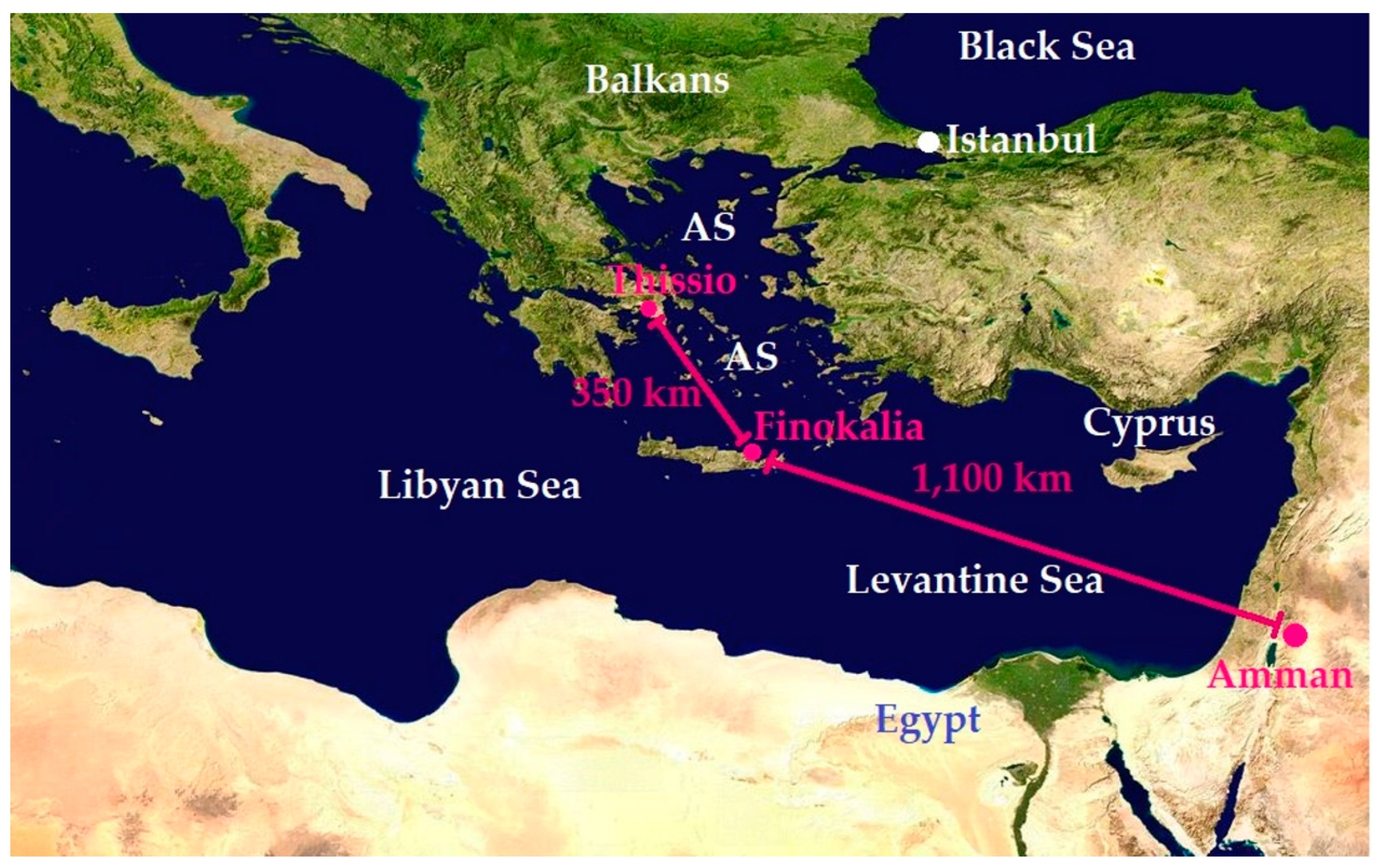


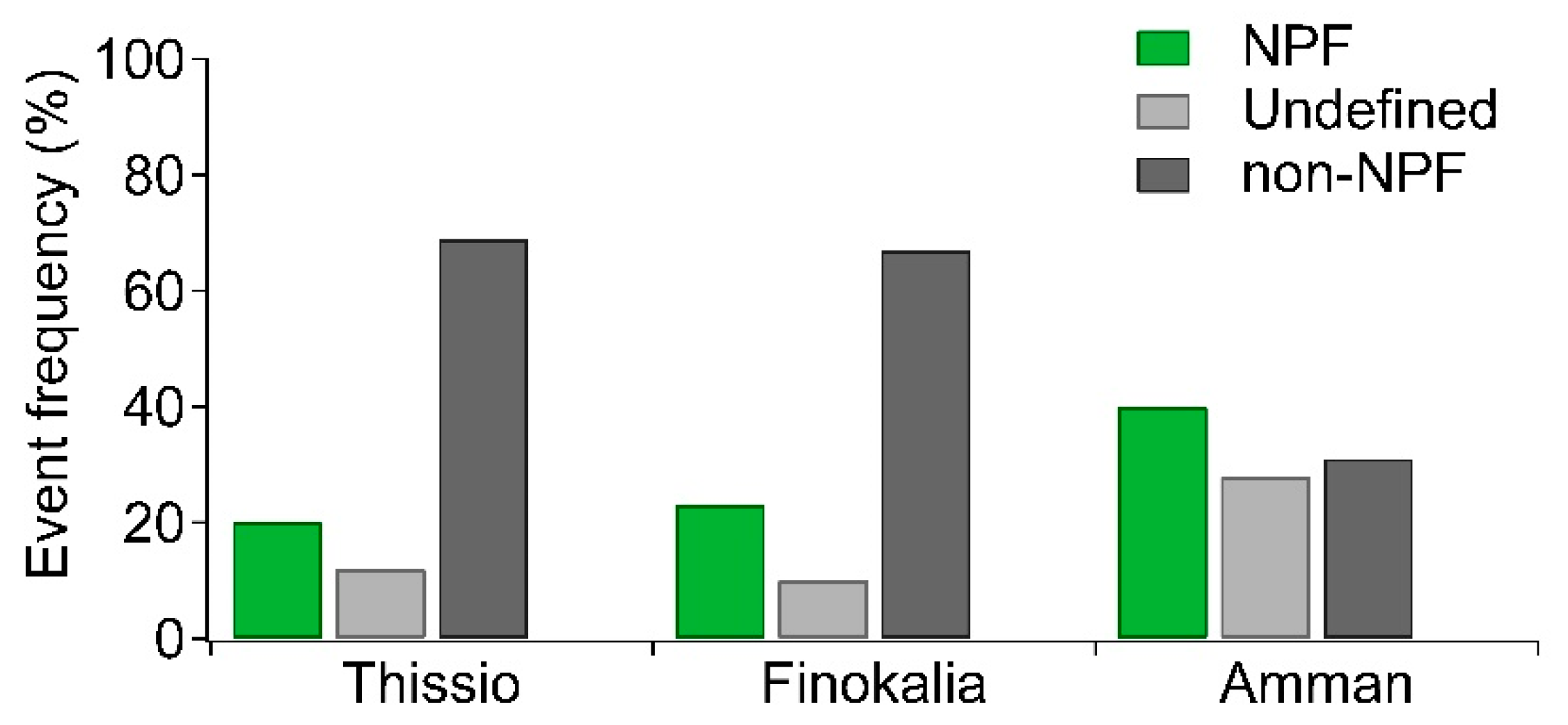


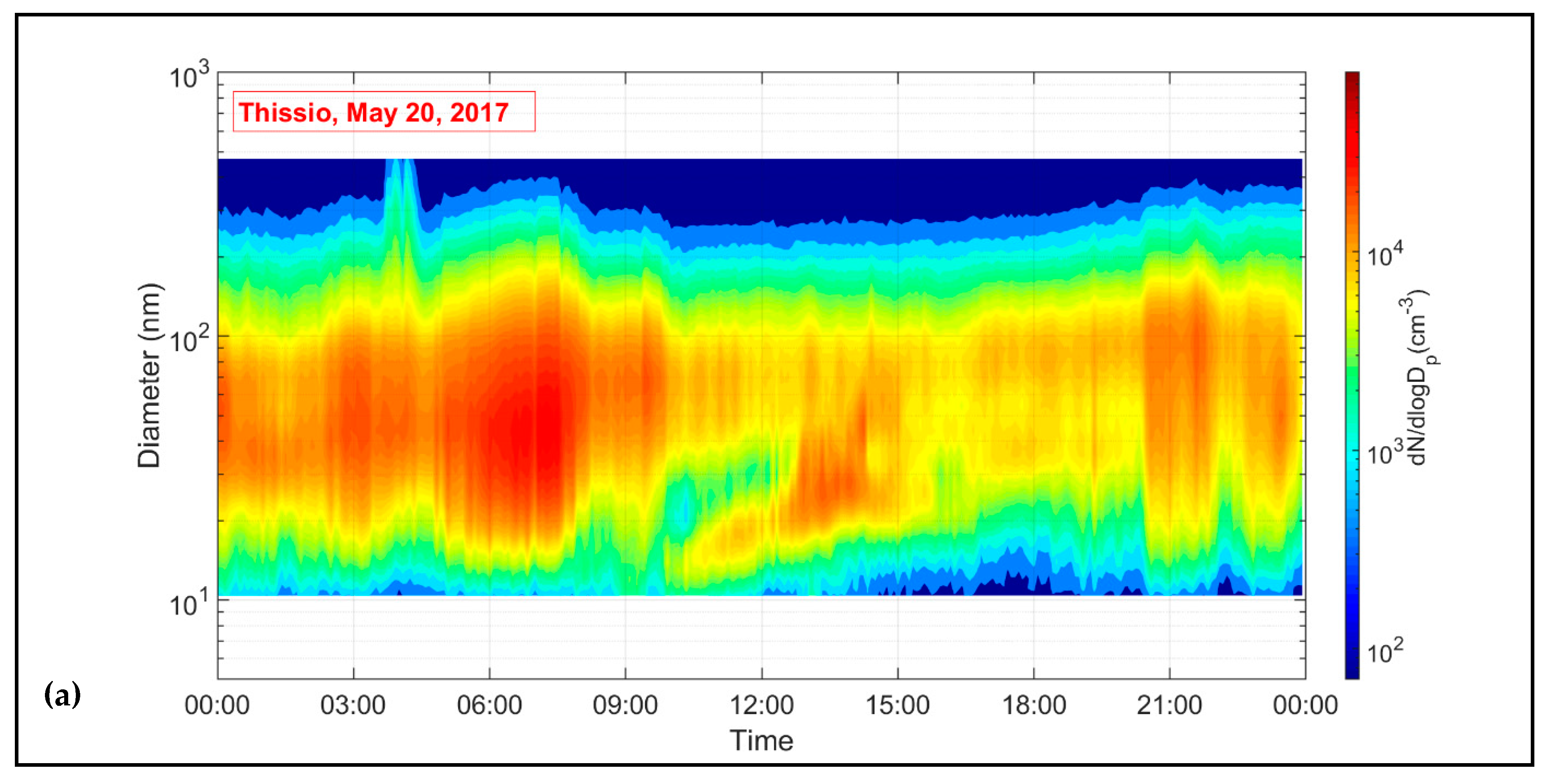
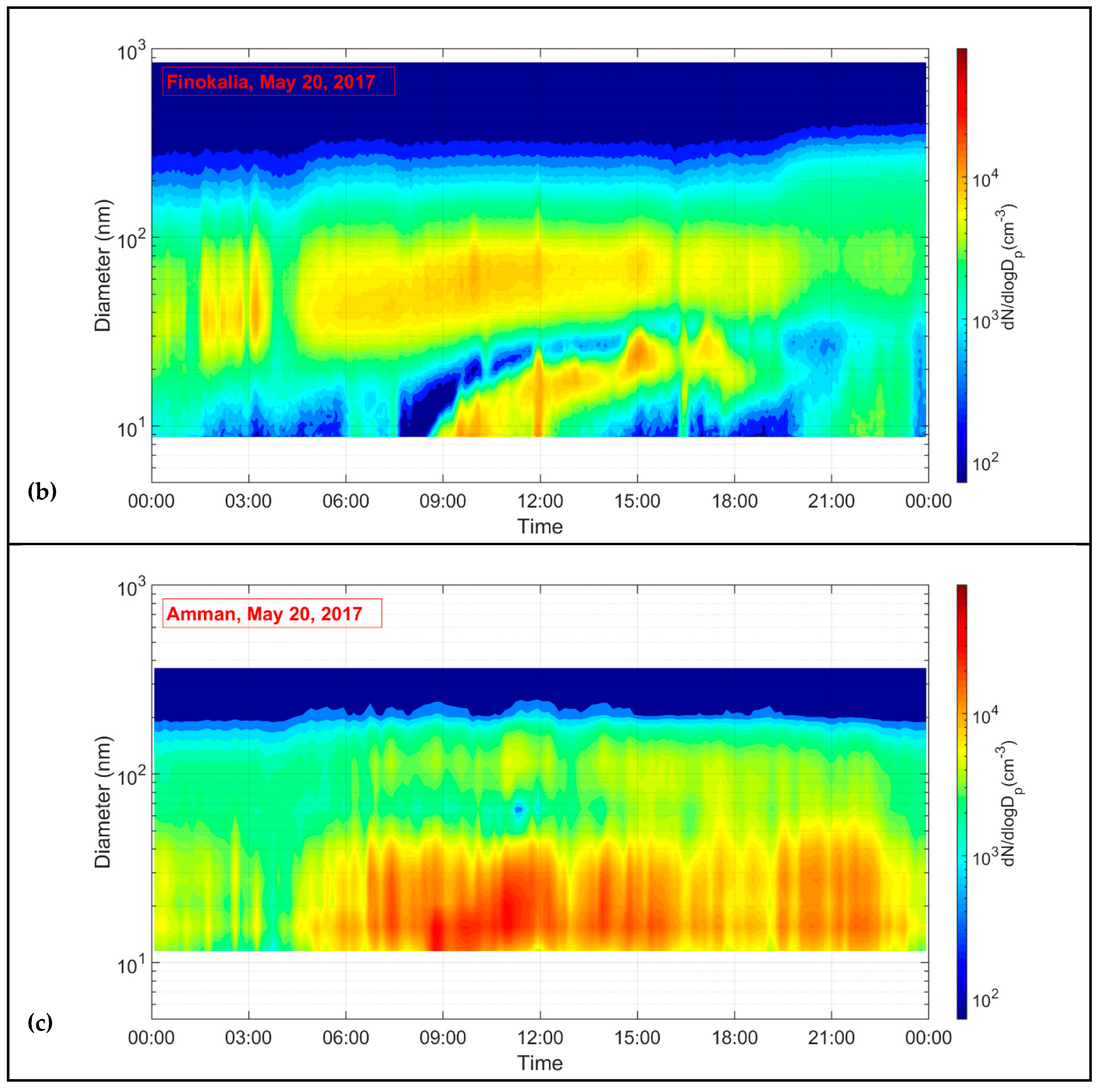

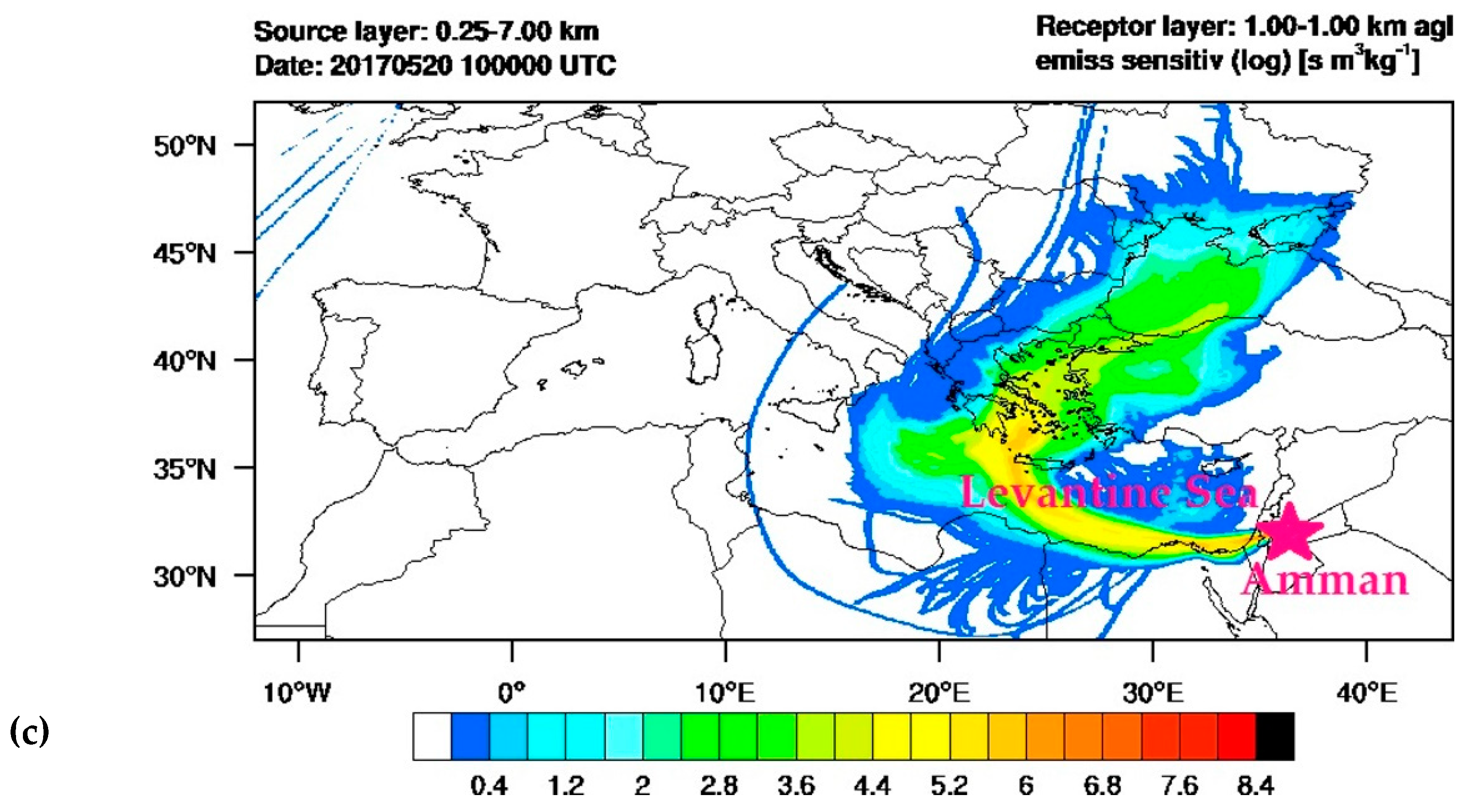

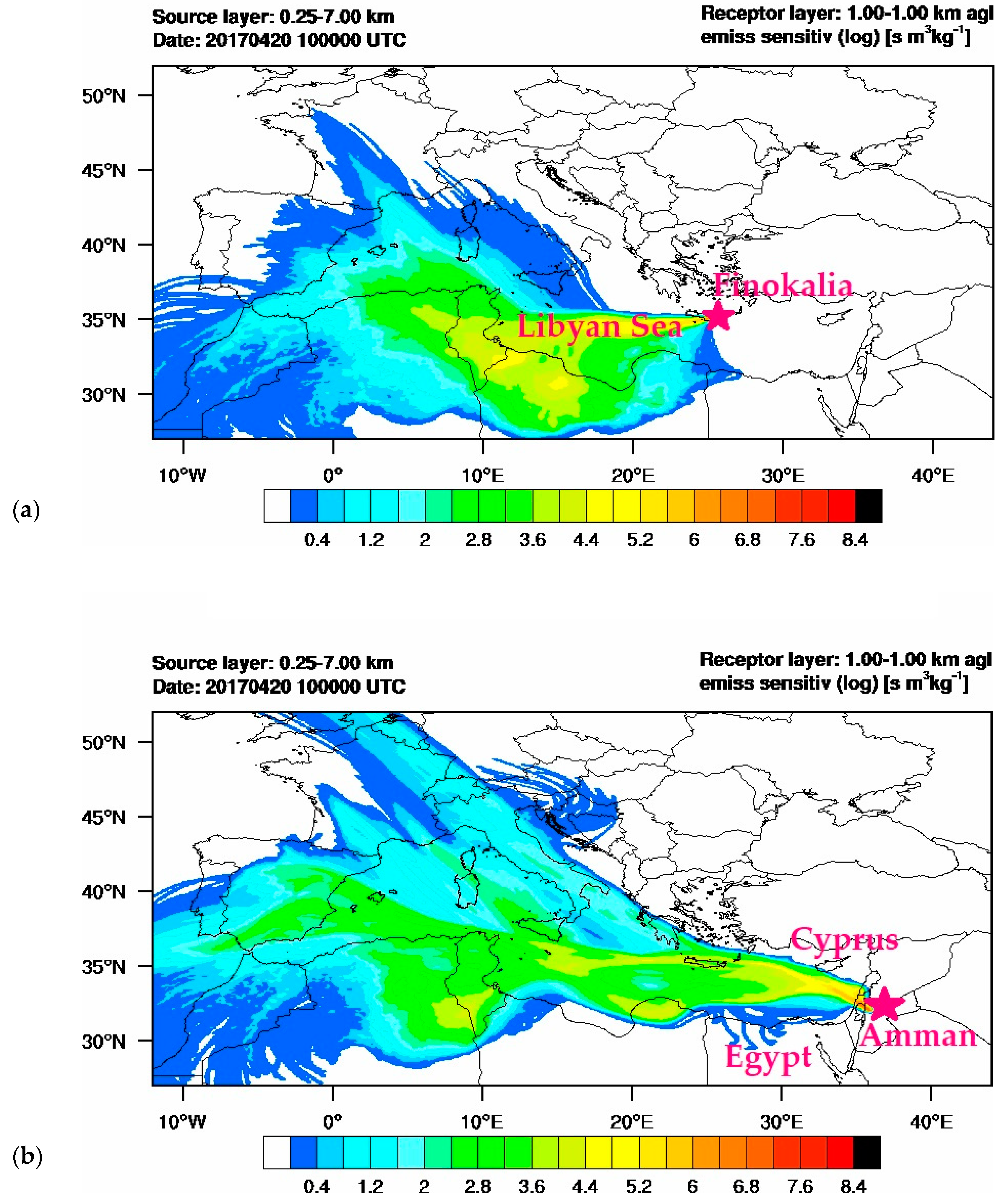
| Day Classification | Thissio | Finokalia | Amman | |||
|---|---|---|---|---|---|---|
| Number of Events | Frequency (%) | Number of Events | Frequency (%) | Number of Events | Frequency (%) | |
| Total events | 36 | 20 | 41 | 23 | 73 | 40 |
| Class I | 16 | 9 | 12 | 6 | 35 | 19 |
| Class II | 20 | 11 | 29 | 17 | 38 | 21 |
| Undefined | 21 | 12 | 19 | 10 | 51 | 28 |
| Non-event | 124 | 68 | 121 | 67 | 57 | 31 |
| Total | 181 | 100 | 181 | 100 | 181 | 100 |
| Parameter | Thissio | Finokalia | Amman |
|---|---|---|---|
| CS (s−1) | (12.0 ± 4.2) × 10−3 | (6.4 ± 1.4) × 10−3 | (7.9 ± 2.1) × 10−3 |
| J (cm−3 s−1) | 1.7 ± 0.8 | 1.9 ± 1.3 | 2.1 ± 1.1 |
| GR (nm h−1) | 4.9 ± 2.1 | 5.8 ± 2.0 | 6.7 ± 3.4 |
| P | 28 ± 14 | 12 ± 5 | 14 ± 8 |
Publisher’s Note: MDPI stays neutral with regard to jurisdictional claims in published maps and institutional affiliations. |
© 2020 by the authors. Licensee MDPI, Basel, Switzerland. This article is an open access article distributed under the terms and conditions of the Creative Commons Attribution (CC BY) license (http://creativecommons.org/licenses/by/4.0/).
Share and Cite
Kalkavouras, P.; BougiatiotI, A.; Hussein, T.; Kalivitis, N.; Stavroulas, I.; Michalopoulos, P.; Mihalopoulos, N. Regional New Particle Formation over the Eastern Mediterranean and Middle East. Atmosphere 2021, 12, 13. https://doi.org/10.3390/atmos12010013
Kalkavouras P, BougiatiotI A, Hussein T, Kalivitis N, Stavroulas I, Michalopoulos P, Mihalopoulos N. Regional New Particle Formation over the Eastern Mediterranean and Middle East. Atmosphere. 2021; 12(1):13. https://doi.org/10.3390/atmos12010013
Chicago/Turabian StyleKalkavouras, Panayiotis, Aikaterini BougiatiotI, Tareq Hussein, Nikos Kalivitis, Iasonas Stavroulas, Panagiotis Michalopoulos, and Nikolaos Mihalopoulos. 2021. "Regional New Particle Formation over the Eastern Mediterranean and Middle East" Atmosphere 12, no. 1: 13. https://doi.org/10.3390/atmos12010013
APA StyleKalkavouras, P., BougiatiotI, A., Hussein, T., Kalivitis, N., Stavroulas, I., Michalopoulos, P., & Mihalopoulos, N. (2021). Regional New Particle Formation over the Eastern Mediterranean and Middle East. Atmosphere, 12(1), 13. https://doi.org/10.3390/atmos12010013







